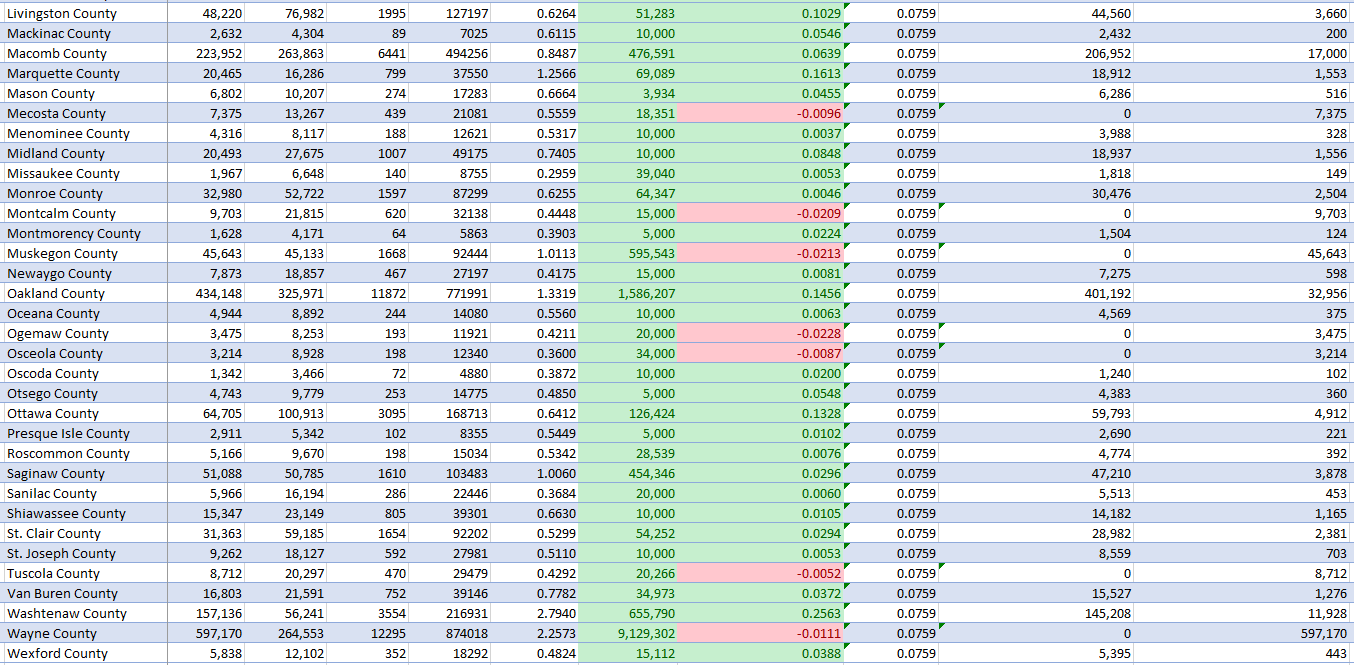The NGO Project Part IV: MI Election Rackateering
How CTCL tipped the balance of the 2020 Presidential Election in Michigan
Introduction
Question: Is CTCL misrepresenting the information on the IRS Form 990 stating that the PURPOSE of the grants were to help support the SAFE administration of public elections during the Covid-19 pandemic?
Answer: It appears so given the results of both aggregate, state and county by county analysis as we will see below. It appears this is a quantifiable Democrat ballot harvesting operation.
Background
This is Part IV in The NGO Project series which examines the role NGOs had in determinative outcomes in the 2020 Presidential Election. In prior articles, I focused on the effect CTCL had on AZ, CO, GA, NM, UT and WI.
This article will solely focus on CTCL in Michigan (MI).
Calculation Basis
The calculation basis was previously explained in detail here. In this article, I do make one adjustment and that is to calculate the 2020DIFF factor by weighted average rather than arithmetic average.
Analysis
In my prior article, I thought WI was bad, but MI is worse in terms of the number of grants made to local government entities which totaled 460. Look at the IRS Form 990, you will find 460 line items for MI.
Of the 83 MI counties, 72 (87%) are classified as CTCL Counties because grants were made to the county directly or cities within those counties. Only 11 MI counties (13%) are classified as NonCTCL Counties.
Here are the NonCTCL Counties.
Total votes cast in CTCL Counties were ~ 5,446,500 (98%) and NonCTCL Counties were ~ 100,500 (2%). To state it a different way, on a per County basis, CTCL had the opportunity to influence 98% of MI voters.
The total amount of grants to MI was ~ $16,763,000 and the value of individual grants ranged from $1,500 to $7,436,450. There were exactly 300 grants valued at $5,000.
This table includes the counties that received more than $50,000 in grants. Again, this is a sum of the grants made within the county not necessarily made directly to the county.
323 (70%) of the 460 grants were for $5,000 or less. Does that strike you as bizarre? Am I to believe that a village mustered the effort to fill out an application and apply for a $1,500 grant and that grant made a meaningful contribution to public safety during the pandemic? The administrative paperwork needed to apply, accept and spend a $1,500 grant hardly strikes me as worth the effort. It would be interesting to FOIA some of these local governments for that information.
The average 2016 D/R ratio for CTCL Counties was 0.68 (not weighted). The average 2016 D/R ratio for NonCTCL Counties was 0.57 (not weighted). This indicates a bias in who received CTCL grants towards D.
However, the top 5 counties in terms grants received ~ $12,800,000 (75%) of the funds and the average 2016 D/R ratio was 1.77 (not weighted). As one might expect, the top 5 counties which voted heavy D in 2016 received 75% of the grants.
2020DIFF Calculated with Weighted Average
For this analysis, I used a slightly different way to calculate the 2020DIFF using a weighted average based on total votes in a county. This is what it looks like.
w = Total County Vote / Total State Vote
a = D/R2020 - D/R2016 (for CTCL Counties)
a' = a * w (per county)
2020DIFF = sum(a'1:a'n)
This method in theory permits a better correlation for D vote harvesting because it is weighted for counties with higher vote totals.
Using this method, the 2020DIFF is 7.6% for CTCL counties.
To emphasize this point, when you calculate 2020DIFF for NonCTCL counties, the value is 0% meaning there was effectively no change in the weighted average between 2020 and 2016 of D and R voters.
Therefore that means that the D difference in CTCL counties was +7.6% more votes per county than had CTCL not been present (7.6%-0%).
Only 11 of 72 CTCL Counties had a -2020DIFF value meaning they trended R despite CTCL spending. For the sake of this analysis, these counties contributed no D votes.
62 CTCL Counties (85%) of the counties had a +2020DIFF value meaning they trended more D in 2020 and did contribute D votes.
The NonCTCL Counties included 4 that had a -2020DIFF but these were for counties that only contributed <2% of the overall votes cast for MI.
What does all of this mean in terms of vote harvesting?
962,000 votes were contributed from CTCL Counties due to the presence of the grants based on a 7.6% harvesting ratio. 597,000 (62%) of those came from Wayne County.
This was enough to flip the state of MI to Biden (2,804,045 votes) from Trump (2,649,864 votes).
Conclusion
CTCL issued ~$16,763,000 grants in MI and “purchased” ~ 962,000 more D votes in CTCL counties than would have occurred without CTCL grants.
That is ~ $17/Vote.
Pretty good return on your investment if you are part of the election racketeering cabal.





